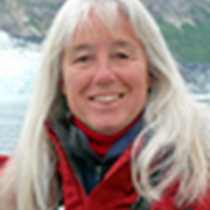Icy Strait/George Island/Elfin Cove/Inian Islands
Icy Strait is very rich in sea life and John’s early wake-up call alerted us to marine mammals in the area. Arriving on the decks, guests were greeted by killer whales! We observed a scattered pod made up of a large male in the distance, some very young animals and various other individuals. At one time we were surrounded on all sides by these beautiful black and white animals. They paid us no mind as they went about their business, undoubtedly searching for food. At the same time we watched some of the bird life, including black-legged kittiwakes, marbled murrelets, loons, and pigeon guillemots. A few humpback whales also made an appearance.
We anchored at George Island and some people went ashore for hikes. There is a gun emplacement here that guarded the entrance to Cross Sound during WWII. Camouflaged banana slugs inhabit the island now.
Other guests took Zodiac cruises along the rocky shoreline of George Island: Sea otters, harbor seals, bald eagles, bull kelp, and whale blows. We ran the gamut with the weather today – interchanging sun, wind, drizzle, and sea swells contributed to the excitement and adventure of the expedition.
We pulled the anchor and before lunch we slipped into the dock at the quaint boardwalk community of Elfin Cove, situated on the northern coast of Chichagof Island. Long-time resident Mary Jo Lord-Wild joined us for lunch on the National Geographic Sea Bird and then gave us some personal insight into life in this remote hamlet, where the young people learn to be self-reliant and in tune with the environment.
We were invited to stroll along the boardwalk, talk with the locals and visiting fisherpeople, pet the dogs, and browse through the gift shops at Elfin Cove. Rufous hummingbirds treated us to their aerial displays and interactions as they competed for “nectar” around feeders. This tiny farthest north hummingbird escapes the severity of winter by migrating to Mexico.
We departed Elfin Cove and cruised into South Inian Pass. Before long, we encountered some humpback whales, including a mother with her calf recently arrived from Hawaii. The young one swam close beside its mother as they rhythmically surfaced, breathed, and dove. It is always heartening to see that the calves have survived the rigors and dangers of their first migration during this vulnerable time. Still nursing, but learning to find and eat other whale food (fish and krill), the calf will double its weight before it returns to Hawaii in the fall.
What luck we had when we came upon more killer whales! This time there were many together in a tight group and we were afforded very close looks from the bow of our ship. The animals can hear our engines but seem unconcerned and unafraid of our proximity. We also cruised by a rock piled with Steller sea lions, situated at a strategic location for catching fish on an incoming tide. Occasional sea otters were also spotted from the decks of the ship.
After a day full of activity and charismatic megafauna and microfauna, the National Geographic Sea Bird Anchored for the evening on the east side of Lemesurier Island and awaited our turn to enter Glacier Bay National Park and continue our amazing experiences in Southeast Alaska.




